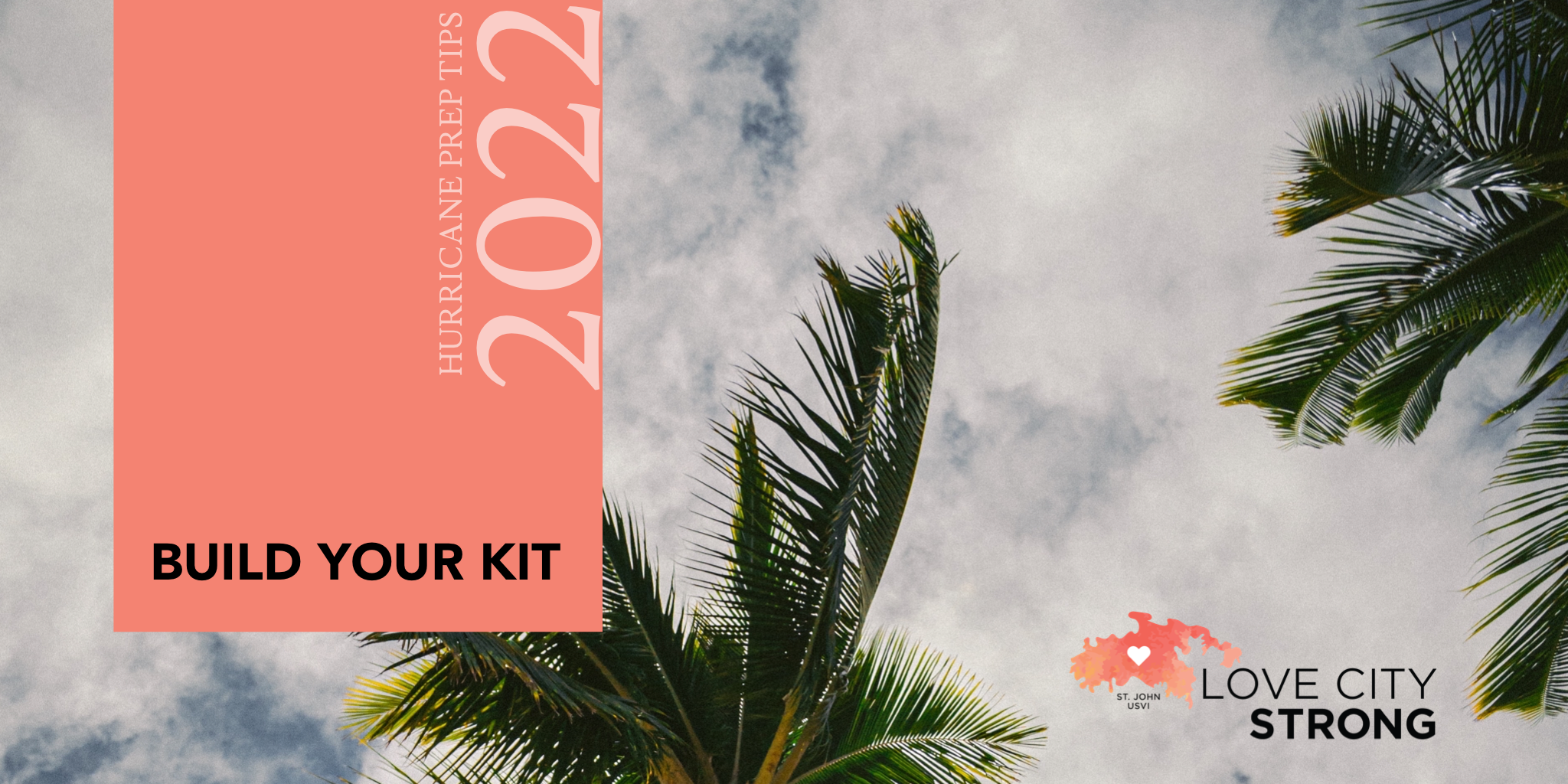
Each year around this time, we emphasize how important it is to build your kit. Generally emergency kits follow a formula : food, water, medicine, important documents… a complete list can be downloaded from Ready.gov. However, all families and households are unique, so what should you consider when building YOUR kit that will ensure it is useful for the whole household?
Access and Functional Needs
If someone in your household has access and functional needs, make sure to prioritize their supplies. This may mean packing an extra pair of prescription glasses or back up contact lenses. Perhaps hearing aids and back up batteries are your priority. Any medical supplies your family uses regularly, like oxygen, insulin, or catheters, for example, should be included. If anyone wears medical alert bracelets or tags, ensure that they are on at all times. For more information on Emergency Preparedness for Individuals with Disabilities and Access and Functional Needs, click here.
Children and Young Adults
Packing a kit for a household that includes small children or young adults is going to be very case specific. Are you a card game or board game family? Pack one or two of your favorite (and smallest) games. Is your teen a big reader? Throw in some favorite books, a book light, and a backup battery or two. If your teen is a gamer, packing a handheld device and an external charger can provide plenty of entertainment. For younger children, a favorite, comforting toy or blanket can help alleviate anxiety, and movies or tv shows downloaded onto a computer or tablet can provide a distraction in a pinch. Ready Kids has lots more great information about kids’ preparedness!
Seniors
Seniors’ comfort should be a top priority. If you are sheltering at home this is more straightforward, but if you need to go to a shelter or evacuate on short notice after a storm, your emergency kit should include a blanket, spare clothes, a jacket, comfortable shoes, and any backup supplies you may need, like adult briefs or wound dressings. Talk to seniors in your family about what forms of entertainment they prefer, and plan accordingly. For more information about how to prepare older adults for a disaster, visit the Red Cross website.
Pets
Pet Preparedness is a topic all its own! In fact, it has its own month! June is Pet Preparedness Month, and all month long Love City Strong will be spotlighting tips and best practices for keeping your animals safe during a storm. Stay tuned to our website and social media for more information!

We often focus on community preparedness here at Love City Strong, but resilience really begins with personal preparedness.
When you’re on a plane and the flight attendant is giving the safety lecture, they always tell you, in the event of an emergency, place your mask on first before helping those around you. Personal preparedness functions in much the same way. By taking action early to ensure that you are as ready as possible, you make yourself more available to help your family, friends, and neighbors in the event of a disaster.
Here are a few tips to help improve your overall readiness, particularly during hurricane season:
Know your needs
Do you have dietary restrictions? Are you on a daily medication? Do you struggle to function without that morning cup of coffee? All of these are things you can plan for in advance. Make sure you have the food you need on hand, and speak to your doctor about how to safely and responsibly build an emergency supply of medication. If coffee is your lifeblood, include a camp stove and a coffee press in your emergency kit!
Know your surroundings
Maybe your home is surrounded by trees, or maybe you’re exposed to a breeze even on a calm day. Understanding your surroundings is the first step to understanding your risk. Check your home and property for potential hazards, and take steps to address them where necessary.
Know the process
Make sure you have emergency contact information written down and readily available. Include family, friends, and neighbors as well as work, insurance, and emergency numbers. Do you have a pet? Include your vet’s number as well.
Plan financially
Even if you can’t spare much, it’s important to try and set aside some emergency cash to have on hand. Whether you save your spare change and singles all year round, or team up with your roommates to start a household emergency fund, or have a savings account that serves the purpose, find a strategy that’s manageable for you and begin the journey. For more information about this and other aspects of financial preparedness, check out this article on Ready.gov.
Think about the “what ifs”
Take a few minutes and imagine what might happen if a storm came through tomorrow. Would you lose power? Would your car be secure? Would you need to reconnect with your family at a predetermined rally point, or would you likely be together? Use the preparedness planning process to poke holes in all the scenarios you can think of, and revise your plan accordingly.
Of course personal preparedness includes many things that we talk about in the context of community preparedness as well. Building a kit, making a plan, strengthening your home… all familiar concepts. The important thing to remember is to address these things in ever expanding circles, starting with yourself, then your family, then neighbors and colleagues, and the greater community. Following these steps now will make you much more useful to them in the event of a disaster!

Here we are in May, again, and it’s time to start thinking about our hurricane preparedness efforts. For those of us who live in “hurricane alley”, these tasks are annual habits. Forming habits can be helpful, but sometimes they can make us complacent. Each year, it’s important to revisit your emergency plan, check your kit, and make sure your home and family are ready for the season.
Threats from hurricanes include powerful winds, heavy rainfall, storm surges, coastal and inland flooding, rip currents, tornadoes, and landslides. Hurricanes can often undergo rapid intensification, meaning they can quickly gain strength before and as they make landfall. For this reason, it’s important to begin your preparation well in advance of an incoming storm. Before hurricane season starts, you should:
- Update your emergency plan with your family
- Check your insurance and strengthen your home
- Assemble disaster supplies
- Help your neighbors
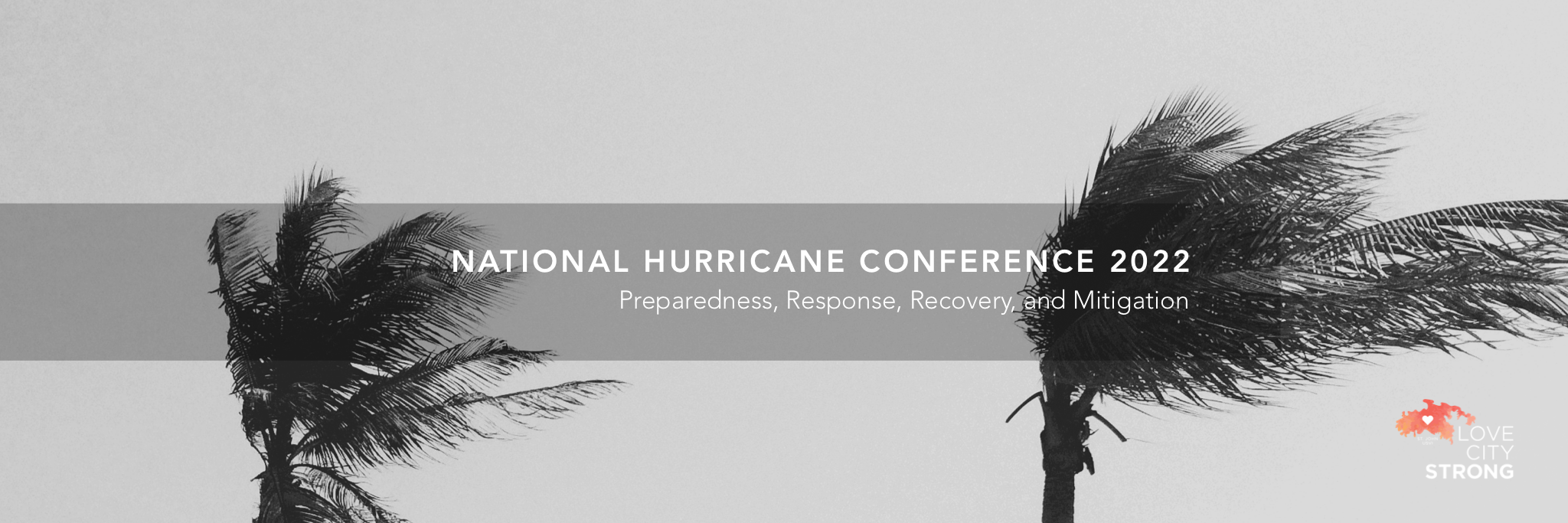
This week, I am pleased to be attending the 2022 National Hurricane Conference in Orlando. This annual event is focused on hurricane preparedness, response, recovery, and mitigation. Panels are focused on a variety of sectors, including technological developments, communications, forecasting, federal mitigation programs, public-private partnerships, and more.
One particularly exciting development this year is the presence of the Territory’s emergency management agency, VITEMA, on several panels. On Monday, Assistant Director Barbara Petersen, Deputy Director for Planning and Preparedness Regina Browne, Deputy Director of Operations Bruce Kelly, and Public Information Officer Erik Ackerson led a panel on local emergency response to the Covid-19 pandemic. Their presentation highlighted some of the challenges the Territory faced, as well as the many successes of VITEMA and the VI Department of Health over the last two years.
On Tuesday, Assistant Director Petersen and Deputy Director Browne hosted a panel focused on the Territory’s Hazard Mitigation & Resilience Plan. They were joined by Dr Greg Guannel, Director of the Green Caribbean Center at the University of the Virgin Islands. The robust discussion addressed climate change, infrastructure, and the need for systemic solutions to complex problems in the Territory.
Wednesday afternoon is dedicated to the NHC General Session. This event will include an appearance by FEMA Administrator Deanna Criswell as well as an Equity in Disasters panel. The Territory’s own Regina Browne is a panelist for the Equity in Disasters session. Along with her, a diverse group of representatives from emergency management organizations and nonprofits will discuss the importance of planning to ensure equity in disaster response.
While the VITEMA panels have certainly been relevant to our work at LCS, other opportunities abound. The NHC provides an invaluable chance to network with emergency managers, federal responders, vendors and subject matter experts from across the country. While each disaster is unique, there’s a great deal we can learn from the experiences of other communities, and we hope that our experiences are valuable to them as well. I am thrilled to be back at the National Hurricane Conference this year, and am already looking forward to next year’s meeting in New Orleans.
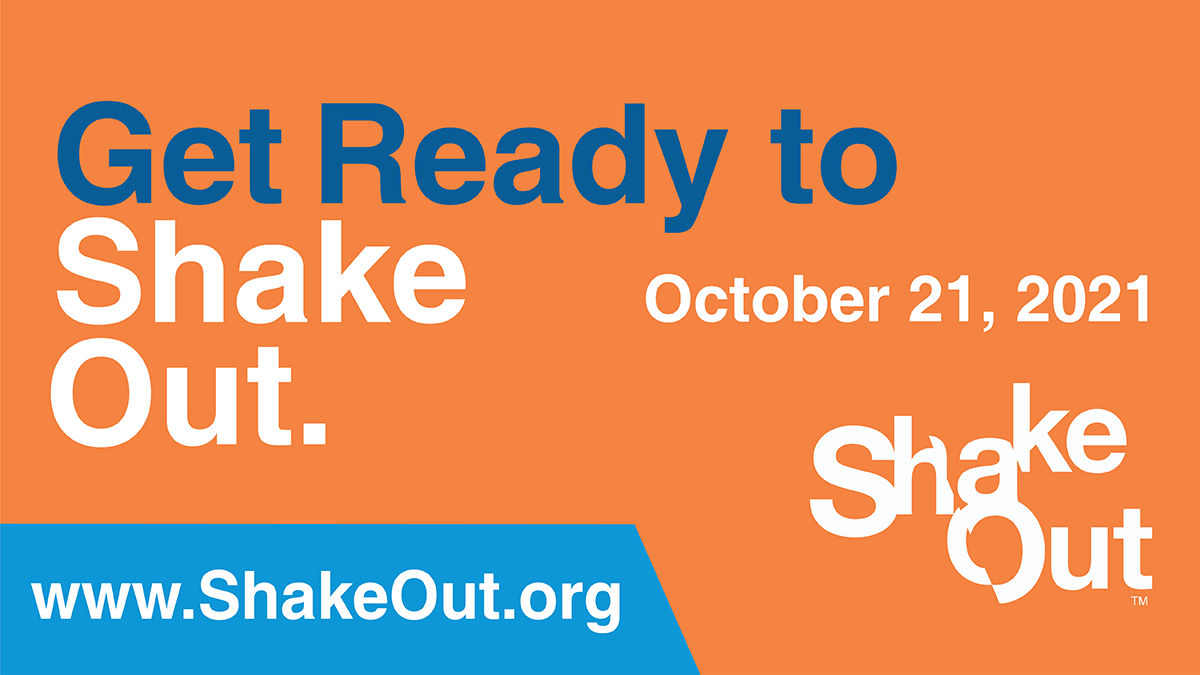
Earthquakes are occurring more frequently across the globe. Unlike many weather-related disasters, earthquakes often come without warning. Therefore it is crucial for households, businesses, and communities to be aware of the dangers that earthquakes pose and to get prepared.
Stay prepared for earthquakes by participating in the International Great Shake Out event (www.ShakeOut.org) on Thursday, October 21!
To participate in the Great Shake Out, visit their website, register, and upload a video of you and your loved ones performing an earthquake safety drill on October 21.
Check out our brand new Earthquake Safety Guide for more information. Print our guide out and place it on your refrigerator, or wherever you keep emergency information in your home. You can find this and other preparedness tip sheets, links, and videos on our What To Know page!
We encourage everyone to take the time to learn about earthquakes, consider what effects they may have on your community, and make a plan to keep yourself safe both during and after a quake. As with any disaster, the only “right time” to prepare is now!

This week, our team partnered with the Virgin Islands Fire Department and Our Lady of Mt. Carmel Catholic Church to help distribute boxes of food to St. John residents as part of the USDA’s Farmers to Families program.
While this is the fourth time that boxes of food have been given out on St. John, the current distribution model relies on those in need going to distribution sites.
Our team’s inclusion in this round of distribution ensured that a crucial group of individuals was able to receive this program’s benefits: Seniors and people with a disability or chronic health condition that renders them homebound. We delivered boxes of food directly to 80 homes across the island in a single day.
Our longstanding model of going directly to those we serve for all of our programs, rather than making them come to us, means that we are uniquely able to navigate St. John quickly and efficiently. This allows us to provide people with goods and services from other organizations who might otherwise not be able to access them.
Thanks to the support of our Board and donors, we are able to provide vehicles for our employees to participate in programs like this. Providing our team with vehicles, PPE, and the tools that they need to do their jobs ensures that they do not have to use their personal property for work purposes. This lends itself to our belief in a strong work-life balance, and strengthens our impact.
Your donations ensure that we can continue to support other organizations’ efforts when we are not working on our own programs. Click here to read more about what we do, and please consider a donation today. With your help, we can keep supporting our community whenever we are able.
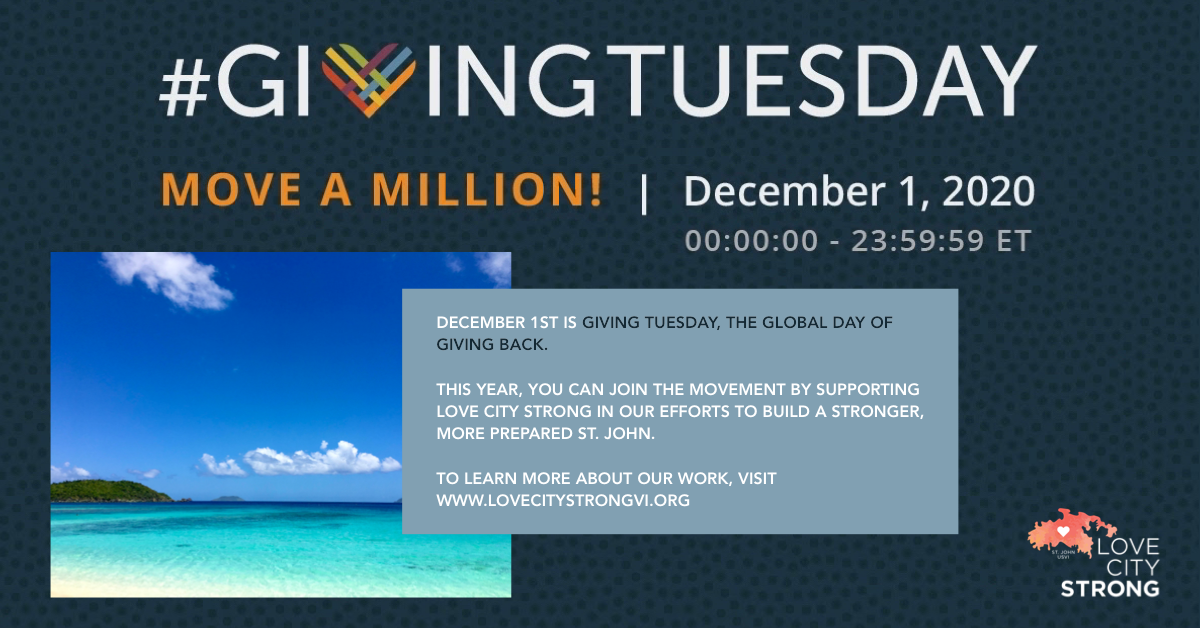
This Tuesday, December 1 is known as Giving Tuesday, the global day of giving back. Giving Tuesday was created in 2012 as a simple idea: A day that encourages people to do good. Over the years it has grown into a global movement that inspires hundreds of millions of people to give, volunteer, and celebrate generosity.
This year, you can join the movement by supporting Love City Strong, and our efforts to create a more prepared St. John. Click here to donate now.
At LCS, our mission is to ensure that the community of St. John is able to respond, recover, and prepare for disasters. Our approach to disaster preparedness centers on three main initiatives: Community outreach and empowerment, stockpiling emergency supplies, and professional training for our team to make us more effective as first responders.
To that end, we have already made a lot of progress over the last 3 years. We created 3 secure storage areas across the island that house a variety of response supplies including boxed water, MREs, solar lights, and first aid supplies. Our team calls or visits over 200 households with seniors both prior to and directly after any tropical weather event of any size; if the senior needs help putting up their shutters or securing their property, we head to their home and help. We have spent several years giving away File of Life and waterproof, flashing emergency lights to people all over the island, and offering to make free home address signs for seniors in an effort to ensure that emergency workers can get to them quicker and easier.
With your help this Giving Tuesday, we can do even more to respond to disasters.
While we often fundraise for specific projects (like the Resilient Housing Initiative), 2020 has taught us that it is important to have unrestricted funding available as well. Unrestricted donations are funds that can be spent on anything that we identify as a community need, rather than specific projects that we are already working on. This ensures that we can spring into action and address any crisis that may arise.
With unrestricted donations, we were able to create and execute community programs in response to COVID-19 quickly and efficiently. This year, programs like our island-wide meal distribution program alongside World Central Kitchen and the purchase and distribution of thousands of reusable face masks across the island were funded by flexible, unrestricted donations. Unrestricted funding also allows us to employ St. John residents and hire St. John businesses to help us do the work.
This Giving Tuesday, join the global movement for good by supporting our efforts through unrestricted funding. If you make your donation via our Global Giving Foundation page, they will distribute additional funds to all of the charities that Global Giving sponsors around the world this year, including LCS, as part of the #MoveAMillion campaign.
No matter which causes you donate to or support this year, we encourage everyone to give a little back this Giving Tuesday. Nonprofits play a crucial role in their communities, and they rely on our love to keep them going. Celebrate their efforts through a donation this December 1.

The Territory entered the 2020 hurricane season on high alert, facing the forecast of an active season paired with the COVID-19 pandemic. At Love City Strong, we began modifying and updating our preparedness and response plans early on, reaching out to our partners at Virgin Islands Territorial Emergency Management Agency (VITEMA), the Virgin Islands Department of Health (VIDOH), the Virgin Islands Department of Human Services, and the Centers for Disease Control (CDC) for guidance and best practices for responding to a disaster during a global health crisis.
Thanks to our work responding to the pandemic on St. John, our team was already used to wearing personal protective equipment (PPE) and adhering to social distancing protocols. We modified our annual community outreach programs, becoming less reliant on public events and leveraging public and private partnerships in order to successfully respond to two significant weather events while keeping residents informed.
Tropical Storm Isaias impacted the Territory on July 29th, and our response lasted from July 25th through July 30th. This large system moved quickly, but did not turn into a tropical storm until it passed just south of St Croix. Our team remained on alert and executed pre- and post-storm wellness checks in the community, shifting from at-home visits to conducting them entirely over the phone. We assisted residents with downed trees and minor storm debris on their property, and brought resources like solar powered lights to those experiencing power loss.
A wave of severe weather associated with Tropical Storm Laura impacted the Territory in the early morning hours of Saturday, August 21st. Once again, what was expected to be a significant rain event stayed to our south, resulting in a limited impact. Within 24 hours of the forecast impact, we knew that the path would keep Laura from being much of a threat to the USVI, but our team continued to execute pre- storm wellness checks, and helped several residents with boarding up and clearing their property.
This hurricane season saw us working closely with VITEMA and our other government partners, as well as our sister nonprofits affiliated with Virgin Islands Voluntary Organizations Active in Disaster (VI VOAD), to keep St. John prepared. Between storms this year, we delivered sandbags to over 100 households, and handed out blue roofing via a drive-through system alongside our partners. Both of these events would normally be done in the form of large public gatherings, but we were able to execute them successfully while still observing social distancing and PPE use.
The 2020 hurricane season taught us much about the unpredictable nature of disaster preparedness, and emphasized the complex relationship between multiple disasters that share the same impact window. I am proud of the work our team has done this year, in the face of so many challenges. As the season comes to a close, we look forward to further refining our deployment plans, expanding our preparedness and resilience programming, and serving the community in the years to come.

Almost a year into the COVID-19 pandemic, it’s understandable that many are starting to develop a sense of emotional burnout that some are calling “covid fatigue.”
The sense of a never ending struggle against an invisible threat may cause people to let their guard down. After all, it can feel wrong to continue to rearrange your life and practice all of these new habits if your risk seems nonexistent. However, this behavior is precisely what leads to surges in COVID-19 cases.
As cases begin to increase globally, particularly in the United States, anecdotal evidence suggests that “covid fatigue” is playing a major part. People are tired of not seeing their loved ones, and staying socially distant, and making dramatic shifts in how they interact with the world.
What’s troubling is that this societal shift is about to converge with the holiday season; a time when people around the world come together with loved ones and celebrate long standing traditions with their communities. These celebrations usually occur indoors, in large groups, and almost always involve older members of one’s extended family or community.
Given that most of us have not seen our loved ones this year due to the pandemic, it can be tempting to completely relax our habits for the holidays and to act as though we live in a world free of risk. The sense of comfort and nostalgia that the holidays give us seem like the perfect solution to our pandemic woes. Unfortunately, the traditions that many of us crave are exactly the kinds of scenarios that put us and others at risk.
It is more important than ever that we begin to workshop creative solutions and start new traditions in order to celebrate the holidays during the pandemic. Whether gathering in smaller groups with immediate members of your household only, taking more time off of work or school to allow for adequate quarantine on either side of holiday travel, or making celebrations entirely virtual, any amount of mitigation will be better than none.
Here are a few key questions to consider when making holiday plans this year:
- What risk are you placing on others (particularly seniors or those who are immunocompromised) with the celebrations that you are planning?
- How can you modify your normal plans to allow for social distancing, or even to have events outdoors rather than indoors?
- For those traveling, what is the status of the virus in your community, and the community that you’re traveling to? Is it fair to put a strain on another community’s healthcare system, or put loved ones in another community at risk, for the sake of not celebrating the holidays in your own community?
- Do you have the resources and time to get tested and self-isolate before celebrating the holidays with people you do not live with?
- Should you set boundaries and expectations with others (and avoid those awkward conversations about why you won’t be hugging anyone this year) ahead of time?
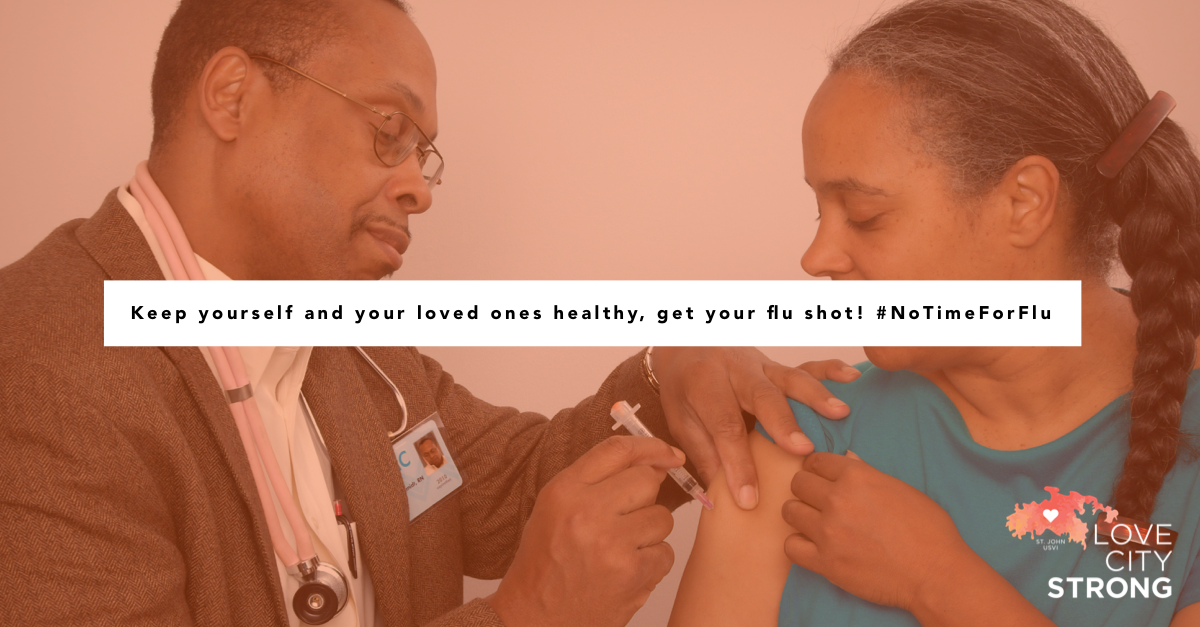
Healthcare professionals around the globe are gearing up to fight two deadly threats simultaneously: COVID-19 and the flu. Seasonal flu viruses are dynamic, and their health risks and severity vary year to year.
However, the flu virus is one of the leading causes of death in the United States. With high risk populations already ravaged by COVID-19 this year, it is more important than ever that as many people get vaccinated for the flu as possible.
Even for those who are young, healthy, and have no preexisting conditions, getting a flu vaccine is important. By getting vaccinated, we prevent ourselves from becoming vectors of disease and causing undue harm to others. The CDC estimates that flu vaccinations in the U.S. reduce the risk of illness for 40-60% of the overall population; the more people who vaccinate in a community, the more that a community is protected.
While it is true that there is overlap between mitigation measures which help prevent the transmission of COVID-19 and influenza (washing hands frequently, sanitizing surfaces, wearing a mask, and staying away from others if you feel sick), practicing these habits may not be enough to help healthcare providers combat two viruses simultaneously during the 2020/2021 flu season.
Although last year’s final flu season numbers are not yet available, preliminary CDC data shows that between 39 and 56 million Americans contracted the flu last year, with over 400 thousand hospitalizations nation-wide. With COVID-19 pushing PPE supplies and hospital capacity to the breaking point, a serious flu season could cause local healthcare systems to utterly collapse. Limiting the burden on our healthcare systems and healthcare workers in any way that we can is critical.
During this time of uncertainty, it is incumbent on each of us to do our part to protect our communities. Think of getting your flu shot not as a chore, but as an act of civic responsibility. Flu vaccinations are a simple action that has the potential to save lives, support our healthcare workers, and make a real difference.
Visit www.GetMyFluShot.org to learn more.
For a partial list of vaccination providers in your area, click here.
